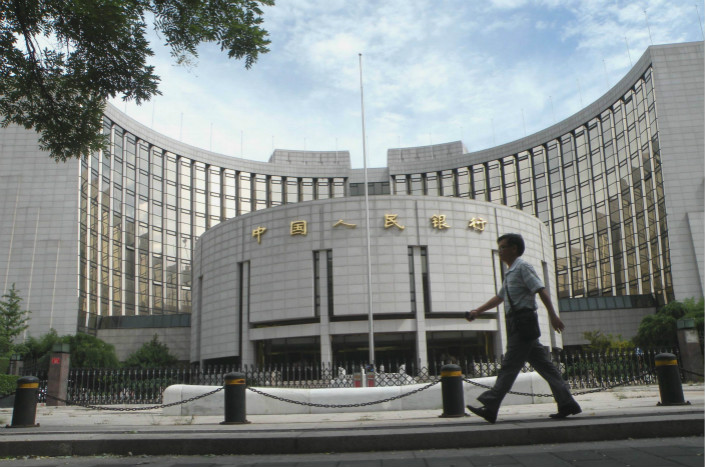China’s Central Bank Unveils Tool Aimed at Lending to Small Firms

China’s central bank unveiled a new policy tool Wednesday to support lending to small and private businesses, a measure some analysts read as a targeted rate cut.
The People’s Bank of China disclosed the new tool, called the targeted medium-term lending facility (TMLF), in advance of the U.S. Federal Reserve’s widely expected quarter-point rate increase Wednesday, the fourth rise this year. The two countries locked in a trade war moved further in opposite directions on monetary policy.
The TMLF will provide a “long-term, stable source of funding for financial institutions based on growth of their loans for small and private firms,” the PBOC said on its website.
The TMLF will have a maturity of one year, but banks can roll loans over twice, increasing the maximum maturity as long as three years, the central bank said. The one-year interest rate on the TMLF will be 3.15%, 0.15 percentage point lower than the rate on the medium-term lending facility (MLF), another tool introduced in 2014 to allow commercial and policy banks to borrow from the central bank at a lower rate.
“The targeted rate cut has arrived,” said Ming Ming, a fixed-income analyst at Citic Securities Co.
The central bank has been easing monetary policy for nearly a year by cutting the reserve-requirement ratio four times this year, but the slowdown in credit growth and companies’ financing difficulties haven’t shown signs of significant improvement.
The growth of outstanding total social financing slowed to a record low of 9.9% in November from 10.2% in October, data from the central bank showed.
Meanwhile, China’s gross domestic product grew 6.5% year-on-year in the third quarter, its slowest quarter of growth since 2009. The November figures indicated a deeper economic cooling, with retail sales growth plummeting to a 15-year low and industrial production growth falling to its weakest point since 2008.
In this context, it is necessary to use price-based monetary policy tools to solve the high cost of corporate financing, Ming said. Reducing policy interest rates is a preferred way to lower the financing costs for businesses, he said.
But other analysts argued that a lower borrowing cost under the TMLF compared with the MLF is not the same as a rate cut. The TMLF has stricter requirements than the MLF and borrowers need to meet certain conditions, while the MLF is operated monthly and has no restrictions on mandatory use of funds, analysts led by Chen Jianheng, a fixed income analyst at China International Capital Corp., wrote in a research note.
Unless the central bank lowers the MLF rate, a lower rate on the TMLF shouldn’t be seen as a rate cut, Chen said in the note. In addition, it’s not clear how much money the central bank will release through the TMLF, so whether it will really lead to more-ample liquidity in the banking system remains to be seen, Chen said.
Qualifying large commercial banks, joint-stock banks and big-city commercial banks showing strong support for the real economy and meeting macro-prudential requirements can apply for the TMLF, and the central bank will decide on the amount of funds to be provided depending on their lending to small and micro-sized enterprises and private companies, the central bank said.
Separately, the PBOC said it would add 100 billion yuan ($14.5 billion) of quota to its relending program to encourage more bank loans to small businesses. The central bank increased the relending quota in June and October by a combined 300 billion yuan.
In a Q&A posted on the PBOC’s website, the central bank said the use of the relending quota by small and medium-sized financial institutions has shown good effect.
As growth in the world’s second-largest economy slows, there have been more debates recently on the possibility of rate cuts.
When asked in October about the right time for a rate cut, PBOC Governor Yi Gang said he still sees plenty of room for adjustment in monetary policy, including interest rates and the reserve requirement ratio.
“Considering that the Federal Reserve is raising interest rates, China’s interest rate level is appropriate, and our tools are sufficient to deal with the uncertainty,” Yi said at a seminar on the sidelines of the annual International Monetary Fund and World Bank meetings on the Indonesian island of Bali.
Changjiang Securities Chief Economist Wu Ge said he sees possible rate cuts in 2019. As the downward pressure on the domestic economy increases, it is expected that monetary policy will be shifted from structural “drip irrigation” to “moderate expansion,” Wu said.
But Lu Zhengwei, chief economist at Industrial Bank Co., said lowering the cost of the central bank’s loans to commercial lenders, rather than cutting benchmark lending rates, can avoid a leverage-ratio rebound and help stabilize market expectations for the exchange rate.

- 1In Depth: A Lost Masterpiece’s Return Exposes Scandal at a Top Chinese Museum
- 2China Launches $14 Billion State Fund to Back Strategic Tech Industries
- 3Offshore Yuan Breaches 7.0 Per Dollar to Hit 15-Month High
- 4In Depth: Memory Shortage Creates Space for China’s Lesser-Known Chipmakers
- 5Weekend Long Read: When China Speed Meets Brazil Rhythm
- 1Power To The People: Pintec Serves A Booming Consumer Class
- 2Largest hotel group in Europe accepts UnionPay
- 3UnionPay mobile QuickPass debuts in Hong Kong
- 4UnionPay International launches premium catering privilege U Dining Collection
- 5UnionPay International’s U Plan has covered over 1600 stores overseas






